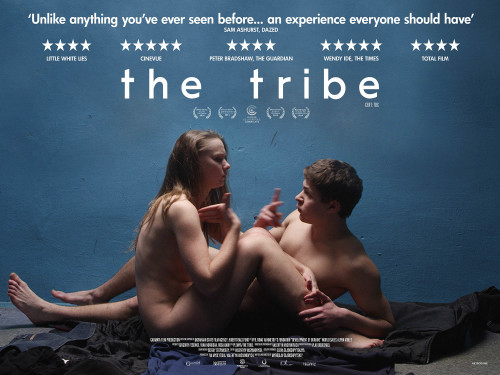“The silent pictures were the purest form of cinema; the only thing they lacked was the sound of people talking and noises. In many of the films now being made, there is very little cinema. They are mostly what I call ‘photographs of people talking.’ When we tell a story in cinema, we should resort to dialogue only when it’s impossible to do otherwise.”
Alfred Hitchcock in Hitchcock, by François Truffaut
Writer/Director Miroslav Slaboshpitsky said in an interview that he was inspired to write his film The Tribe because he attended a school that was near a school for the deaf when he was younger. (Incidentally, Slaboshpitsky filmed The Tribe at his old school.) There were fights from time to time between students from his school and the deaf students. He carried these memories for many years, finally unleashing them in a film that has gathered both praise, and in some places, ridicule for being a gimmick film, a one-trick pony only being celebrated because it is a story told completely in Ukrainian Sign Language.
There are no subtitles, no voice-overs, no music or sound design. The only sounds we hear are natural noises around the actors–à la dogme films— when they move within rooms slamming doors, are in cars, are outside walking in snow, or the excited vocal inflections emitted from an agitated signer who often uses sharp finger pokes and hand slaps to catch the attention of people not looking them in the eye. Viewing the film is pretty close to Hitchcock’s idea of “pure cinema.” Viewers don’t even know the names of the characters because our eyes have to do all the work, and we are basically resorted to assigning actors descriptive traits for names like New Kid, Kingpin, Boss Man, Blonde homegirl, and Brunette homegirl to track folks. (After viewing the film, I had to go online and check to see if the actors were even assigned names.)
Not since the silent films during the pre-sound era assigned to me during college have I experienced a film where I had to work at understanding and interpreting human interactions with visuals only. The fascinating part of Slaboshpitsky intentionally making viewers work at comprehension is that my interpretation of the film might be completely different from someone else.
Sergey (Grigoriy Fsenko) is a deaf high school student who tries to fit into his new boarding school and becomes ensnared in a criminal enterprise ran by a gang of older male students and a woodshop teacher. They are into everything. Petty theft, burglary, prostitution, bullying, and assaults on other students. These kids are the poster children for Thug Life Ukraine.
For the first ten minutes of the film, we are forced to orient ourselves. What may appear to be a slow and tedious start is really narrative time designed to acclimate and settle hearing viewers into leaning on visual cues full throttle. We become Sergey trying to figure out the place and its pecking order. Sergey is given instant sympathy because he has no idea what he is getting himself into. He can barely find a room and a bed to occupy before he’s pushed around and forced to sleep in the hallway on his first night. Eventually Sergey is jumped into the “gang” and the film branches out to the other characters. We are witness to the evening prostitution where two teen-aged girls, who are part of the crew, are driven off campus to truck stops by the woodshop teacher and a student handler/pimp. The girls have quick hook-ups inside the trucks, the teen handler/pimp collects the money, and at the end of the night, the woodshop teacher drives them all back to school.
The film moves through arcs of pity, empathy, and then downright horror. Violence is abrupt and can come from anyone. I was blessed to watch the film with an audience that was one third deaf, and the experience of witnessing visceral scenes with the sounds of hands pounding, slapping, moving around me with frantic finger blurs of American Sign Language made the viewing electric.
There are only two main female characters in The Tribe, a blonde and a brunette who are dorm roommates and apparently best friends. It would be easy for me to write that they are just objects used throughout the film. They are. But all the underlings in the gang are objects. All bodies are commodities used for profit, from the elementary-aged boys sent out to sell cheap souvenirs on the trains and streets (while also lifting a wallet and a purse or two), to the crews that roam the streets at night to roll over some unlucky citizen walking home at night with groceries.
Unfortunately for this film, the female presence is only used for sexual exploitation. The females are not calling any shots and aren’t bossing any underlings around. They are there to pleasure men. Perhaps it would be different if there were some teen-aged boys also being prostituted along with the girls when they were dropped off at the truck stop. Or at least more girls participating on the stroll and other girls involved in different parts of the criminal enterprise other than prostitution. At least there would be a balance and a sense of “it is what it is.” (I’m not advocating that seeing more girls pimped in the film makes it better in that world, but it might give a semblance of business is business and the female characters were there to make money and have agency for themselves too.) This shouldn’t deter people from seeing the film, it’s just my observation that sometimes screenwriters stick women in scripts for titillation purposes and not as fully realized characters integral to the plot.
There is a lot of sex in the film that isn’t romanticized. People fuck. And not for love. This leads to one of my favorite scenes in the movie. Anya (Yana Novikova) completes a night of sex work and Sergey (her new handler/pimp) walks her back to their dorm. As handler payment (a reward given to the guys who escort the two girls at night to the trucks), Anya hikes up her skirt inside a cold dirty room, bends over and offers her backside to Sergey to do what he will. It’s very clinical, no foreplay, just stick your penis here boy and be done. Sergey flips the encounter on Anya and makes a pallet on the floor and mounts her missionary style so he can see her face. He tries to kiss her, but she protests and turns her head. Eventually they switch positions again, and while sexually spooning her, he manipulates her clitoris and Anya appears aroused and surprised that a male would take time to pleasure her during the act. We watch everything in real time (and full nudity), and when they climax, Anya kisses him. It’s a lovely scene because the sex moves from a passionless unfeeling payment fuck for Anya, (although Sergey is clearly in love with her) into a tender moment where we witness the first sign of emotional connection between anyone in the film. It’s a plot point that eventually spirals the film toward a cringe-worthy abortion sequence and then onto its horrific conclusion.
The sex added a layer to Sergey’s character that I wasn’t expecting. The audience assumes from his earlier awkwardness that he was just a virginal follower, clumsy with girls, and knowing nothing. But watching their sex scene I was struck at how insistent he was at touching Anya in a particular way, moving her into positions not with awkward fumblings, but with an experienced need to please her. It was the first clue Sergey wasn’t what he seemed. Later in the film we find out that we were wrong about him from the start.
The conclusion of The Tribe reminded me of Gaspar Noé’s Irreversible. It is brutal and heart-wrenching in its abrupt closure. The film stays with you. I spent a few days trying to process what it meant to me as a viewer. Was my interpretation of the events correct? Did my eyes deceive me? What social clues did I miss because I don’t know Sign Language? The Tribe was pretty close to pure cinema. It has a seventies realism that I miss in movies today, and the actors look like regular people, not Hollywood augmented look-alikes. The cast is made up of deaf untrained actors who do a hell of a job bringing this world to life. It’s not a film for everyone, but I hope people will step out of their comfort zone to watch it. It will haunt you.
Staff Writer Lisa Bolekaja can be heard co-hosting Hilliard Guess’ Screenwriters Rant Room (the latest episode featuring Empire TV series writer Carlito Machete). Her most recent Sci Fi short story is in Uncanny Magazine, and she can be found on Twitter lurking in the tags #SaturdayNightSciFi and #FridayNightHorror @LisaBolekaja















